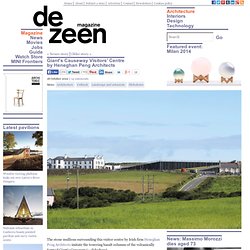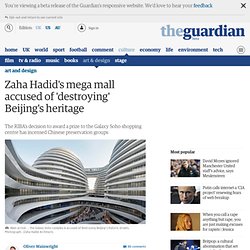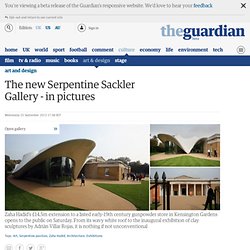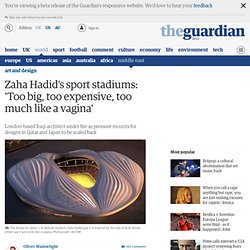

Hyogo Prefectural Museum of Art 효고현립미술관. Rem Koolhaas's De Rotterdam: cut and paste architecture. If you put the last 50 years of architecture in a blender, and spat it out in building-sized chunks across the skyline, you would probably end up with something that looked a bit like Rotterdam.

Walking the streets of the Netherlands' second-largest city is like trawling a back catalogue of architects' bold dreams and daring attempts. There are buildings shaped like sharpened pencils and forests of floating cubes, towers dressed in bright red pinstripes and blue harlequin chequers, odd lumps and improbable cantilevers thrusting out in all directions. All this is the consequence of the city suffering a bombardment of two things: bombs and architects. Rotterdam was flattened by the Luftwaffe during the second world war and has since served as a hotbed of experimentation, becoming a natural home for the country's architectural avant garde.
Giant's Causeway Visitors' Centre by Heneghan Peng Architects. The stone mullions surrounding this visitor centre by Irish firm Heneghan Peng Architects imitate the towering basalt columns of the volcanically formed Giant's Causeway (+ slideshow).

Created around 60 million years ago by the movement of basalt lava, the causeway is the most popular tourist attraction in Northern Ireland and comprises over 40,000 columns that step down from the foot of the cliff into the sea. Heneghan Peng Architects won a competition in 2005 to design a visitor centre for the Giant's Causeway, providing exhibition spaces, a cafe, toilets and a giftshop. The new building opened this summer and is described by the architects as "two folds into the landscape". The first fold rises up from the ground to create a building with a sloping grass roof, while the second angles down to form a car park and entrance that meets the level of the approaching road.
"It is a carefully sculpted intervention," say the architects. Photography is by Hufton + Crow. Zaha Hadid's mega mall accused of 'destroying' Beijing's heritage. Beijing's street names can be deceptive.

Visitors to No 7A Small Arch hutong, just inside the city's second ring road, might get a little more than they bargained for. Long gone is the stone gateway that once marked the entrance to this network of narrow streets. Now, it's been replaced by a sinuous white arc, jacked 60m into the air, that loops and twists, connecting a cluster of vast egg-shaped buildings in an improbable acrobatic leap. This alien arrival is Galaxy Soho, a 370,000 sq m complex of shops, offices and restaurants by Zaha Hadid Architects, recently bestowed with a top award by the Royal Institute of British Architects (RIBA). The judges heaped praise on its flowing bands of white aluminium and glass that “give the development an almost geological solidity and presence”. But others in Beijing beg to differ. “Many of us in Beijing are very disappointed and offended,” the letter said. Zaha Hadid: 'I don't make nice little buildings'
The Zaha Hadid gallery contains a metropolis in miniature, a streetplan of fantastical scale models preserved under perspex.

Hadid's PR walks me down the aisles and points out the landmarks. Over here is the imposing MAXXI museum in Rome and over there the BMW plant in Leipzig, where translucent conveyor belts ferry the cars between the factory floors. Away in the corner, the gallery floorspace is occupied by what appears to be a white, frozen avalanche of futurist geometry. This, I am told, is the design for a building in Saudi Arabia. I stare at the avalanche with mounting alarm.
Increasingly, it seems, Zaha Hadid's concepts are becoming constructions. The new Serpentine Sackler Gallery - in pictures. Zaha Hadid's £14.5m extension to a listed early-19th century gunpowder store in Kensington Gardens opens to the public on Saturday.

From its wavy white roof to the inaugural exhibition of clay sculptures by Adrián Villar Rojas, it is nothing if not unconventional. Zaha Hadid's sport stadiums: 'Too big, too expensive, too much like a vagina' One looks like a futuristic bicycle helmet, stretched across its Tokyo site in an aerodynamic sweep.

The other has been said to resemble a vagina, rising out of the Qatari desert in a great vulvic bulge. Both are in fact sinuous sporting stadiums by the London-based Iraqi architect Zaha Hadid, who is facing calls for her exuberant designs to be scaled back. This week Japanese sports officials finally bowed to growing criticism that Hadid's scheme for the Tokyo 2020 Olympic stadium was too big and too expensive, saying they would shrink the design by a quarter.
The 80,000-seat venue, planned for the site of the current 48,000-seat national stadium, built in 1958, is described by Hadid as "light and cohesive", its structure forming a dynamic bridge that "creates an exciting new journey for visitors". As the feminist website Jezebel put it: "Any discerning human will be quick to recognise that the building looks exactly like an enormous vagina. " Hadid has little time for such lewd comparisons.